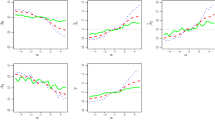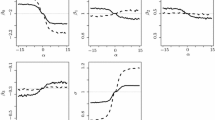Abstract
In the framework of generalized linear models for binary responses, we develop parametric methods that yield estimators for regression coefficients less compromised by an inadequate posited link function. The improved inference are obtained without correcting a misspecified model, and thus are referred to as wrong-model inference. A byproduct of the proposed methods is a simple test for link misspecification in this class of models. Impressive bias reduction in estimators for the regression coefficients from the proposed methods and promising power of the proposed test to detect link misspecification are demonstrated in simulation studies. We also apply these methods to a classic data example frequently analyzed in the existing literature concerning this class of models.






Similar content being viewed by others
References
Aranda-Ordaz FJ (1981) On two families of transformations to additivity for binary response data. Biometrika 68(2):357–363
Bliss CI (1935) The calculation of the dosage–mortality curve. Ann Appl Biol 22(1):134–167
Boos DD, Stefanski LA (2013) Essential statistical inference: theory and methods. Springer, New York
Carroll RJ, Ruppert D, Stefanski LA, Crainiceanu C (2006) Measurement error in nonlinear models: a modern perspective. Chapman & Hall/CRC, Boca Raton
Cleveland WS, Devlin SJ (1988) Locally weighted regression: an approach to regression analysis by local fitting. J Am Stat Assoc 83(403):596–610
Cook JR, Stefanski LA (1994) Simulation-extrapolation estimation in parametric measurement error models. J Am Stat Assoc 89(428):1314–1328
Copas JB (1988) Binary regression models for contaminated data. J R Stat Soc Ser B (Methodol) 50(2):225–253
Czado C, Santner TJ (1992) The effect of link misspecification on binary regression inference. J Stat Plan Infer 33(2):213–231
Guerrero VM, Johnson RA (1982) Use of the box-cox transformation with binary response models. Biometrika 69(2):309–314
Hosmer DW, Hosmer T, Le Cessie S, Lemeshow S (1997) A comparison of goodness-of-fit tests for the logistic regression model. Stat Med 16(9):965–980
Jiang X, Dey DK, Prunier R, Wilson AM, Holsinger KE (2013) A new class of flexible link functions with application to species co-occurrence in cape floristic region. Ann Appl Stat 7(4):2180–2204
Kim S, Chen MH, Dey DK (2007) Flexible generalized t-link models for binary response data. Biometrika 95(1):93–106
McCullagh P, Nelder J (1989) Generalized linear models. Chapman & Hall/CRC, Boca Raton
Morgan BJ (1983) Observations on quantit analysis. Biometrics 39(4):879–886
Nelder JA, Wedderburn RW (1972) Generalized linear models. J R Stat Soc Ser A-G 135(3):370–384
Pregibon D (1980) Goodness of link tests for generalized linear models. J R Stat Soc C-Appl 29(1):15–24
Samejima F (2000) Logistic positive exponent family of models: virtue of asymmetric item characteristic curves. Psychometrika 65(3):319–335
Stefanski LA, Cook JR (1995) Simulation-extrapolation: the measurement error jackknife. J Am Stat Assoc 90(432):1247–1256
Stukel TA (1988) Generalized logistic models. J Am Stat Assoc 83(402):426–431
White H (1982) Maximum likelihood estimation of misspecified models. Econometrica 50(1):1–25
Whittemore AS (1983) Transformations to linearity in binary regression. SIAM J Appl Math 43(4):703–710
Acknowledgements
I would like to thank the Associate Editor and the two anonymous referees for their helpful suggestions and insightful comments that greatly improve of the manuscript.
Author information
Authors and Affiliations
Corresponding author
Additional information
Publisher's Note
Springer Nature remains neutral with regard to jurisdictional claims in published maps and institutional affiliations.
Electronic supplementary material
Below is the link to the electronic supplementary material.
Appendix: Proof of equation (2)
Appendix: Proof of equation (2)
Because the assumed GLM is specified by \(P(Y=1|X)=H(\eta )\), where \(\eta =\beta _0+\beta _1 X\), and the reclassified response is generated according to \(P(Y^*=Y|Y, X)=\pi \), one has
It follows that the likelihood function based on the assumed primary model for \(Y^*\) evaluated at one data point \((Y^*, X)\) is \(L(\pi , \varvec{\beta })=P(Y^*=1|X)^{Y^*}\{1-P(Y^*=1|X)\}^{1-Y^*}\), and the log-likelihood function is \(\ell (\pi , \varvec{\beta })=Y^*\log P(Y^*=1|X)+(1-Y^*)\log \{1-P(Y^*=1|X)\}\).
Differentiating (15) with respect to each element in \((\pi , \varvec{\beta })\) gives
Using (16), one can show that the three normal score functions associated with \(\ell (\pi , \varvec{\beta })\) are given by
To further simplify notations, let \(\mu =P(Y^*=1|X)\). The above three score functions can be re-expressed as
The expectation of the first score in (17) with respect to the true distribution of \((Y^*, X)\) is
where \(\eta _0\) is equal to \(\eta \) evaluated at the true value of \(\varvec{\beta }\), and \(\mu _0 =(2\pi -1)G(\eta _0)+1-\pi \), as defined in (4), is the mean of \(Y^*\) given X under the correct model evaluated at the true parameter values. Setting this expectation equal to zero gives the first estimating equation in (2). Similarly, the expectations of the second and the third score functions in (17) with respect to the true distribution of \((Y^*, X)\) are given by
respectively. Setting these two expectations equal to zero gives the second and the third equations in (2).
Rights and permissions
About this article
Cite this article
Huang, X. Improved wrong-model inference for generalized linear models for binary responses in the presence of link misspecification. Stat Methods Appl 30, 437–459 (2021). https://doi.org/10.1007/s10260-020-00529-3
Accepted:
Published:
Issue Date:
DOI: https://doi.org/10.1007/s10260-020-00529-3




